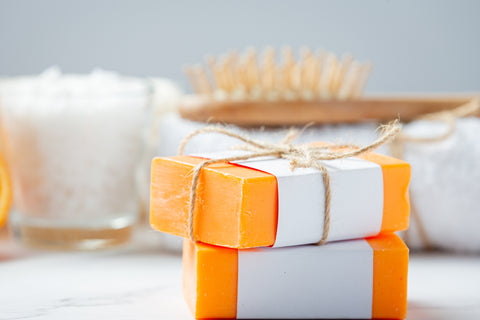How To Make Ylang Ylang Soap at Home
Ylang Ylang soap is an expensive and plush soap that people use in their skincare routine. It is a soap made from an essential oil of Ylang Ylang flower. The Ylang flower is known for its pleasant and flowery aroma.

Its oil makes perfumes and skincare products for its pleasing fragrance. The Ylang soap not only provides a pleasing fragrance but is also known for its various skincare benefits which we will talk about later in detail. It also has humidifying qualities that help in soothing the skin.
Ylang Ylang Soap Benefits
Ylang Ylang soap provides so many rich and luxurious benefits with its pleasant smell of the oil used in making it. This leaves a soother, refreshed, and healthy-looking finish after skincare use. Let us now discuss how Ylang Ylang soap can benefit us in detail.
1. Balancing Oil Production
Ylang Ylang soap helps balance oil production by controlling melanin production, which can be beneficial for both dry and oily skin types. This improves the skin texture and prevents the skin from getting overly oily or overly dry.
2. Sweet Scent
The pleasing, flowery perfume smell of the ylang flower gives a calming finish to the soap that helps reduce stress and anxiety after each wash during the skincare routine.

3. Provides Moisturization
Ylang Ylang soap moisturizes the skin deeply, revealing a soft-looking, smoother skin making it less rough and mushy. This benefits a lot overall and is one of the essential benefits of using the Ylang Ylang soap.
4. Hygienic and Microbicidal
Ylang Ylang soap is very hygienic to use and thus is anti-bacterial and anti-inflammatory. Microbicidal properties help to clean the skin deeply without causing any irritation or redness. This could be very favorable for the ones who have an acne-prone skin.
5. Healthy-Looking Finish
All the benefits discussed above will surely help in giving a healthy-looking skin. Make sure to use it regularly, and be patient with the results, it has rich nutrients in it that will provide you achieve fresh, youthful, and rich-looking skin.
DIY Ylang Ylang Soap Recipes - Step By Step
Who doesn't want to pamper your skin? These Ylang soap recipes with a perfect handful of ingredients ensure calmness and smoothness around your skin, with that flowery scent perfect for pampering your skin. The ylang soap recipe is ideal for your daily skincare routine and adds a touch of serenity.

1. Orange And Ylang Ylang Soap Recipe
Come and let us explore more about ylang-ylang soap recipes, what if we say you will be using oranges for making a ylang-ylang soap? Mind-blowing right?
This combination of oranges and ylang-ylang helps stimulate the aura of citric acid to merge with beautiful ylang-ylang flowers. Let's discuss in detail the recipe for the same.
Ingredients:
- Water - 21 Tablespoons
- Palm Oil - 16 Tablespoons
- Virgin Olive Oil - 16 Tablespoons
- Sodium Hydroxide - 9 Tablespoons
- Virgin Coconut Oil - 16 Tablespoons
- Ylang Ylang Essential Oil - 1 Tablespoon
- Sweet Orange Essential Oil - 2 Tablespoons
Directions to Use:
Step 1: Before starting it, use gloves and safety goggles in an isolated area.

Step 2: Safety and hygiene are the two most important things to focus on before experimenting with any activity.
Step 3: Slowly and gradually, mix sodium hydroxide into water, and wait for it to cool down.
Step 4: Take out virgin coconut oil, palm oil, and virgin olive oil. Melt them together and wait for them to cool.
Step 5: Preparation of oils is the third step in making an orange and ylang-ylang soap.
Step 6: After that, gently add the sodium hydroxide solution to the oils and mix it until it thickens.
Step 7: Mix in orange and ylang-ylang soap oils together thoroughly to achieve a citrus finish.
Step 8: Pour the mixture into the mold and cover it instantly so that air does not get trapped inside.
Step 9: Lastly, it is almost ready to use, unmold the mixture after a day or two, cut it, and treat it for at least a month before use.
2. Lavender And Ylang Ylang Soap Recipe
Experience the Tranquility of ylang-ylang soap with a touch of lavender in it. This recipe is also an ideal recipe for leisure and refreshing cleansing, making every use an escape to serenity.

This combination uses lavender's properties in the making of ylang-ylang soap that reveals a flora charm, achieving a calmness and soothing aura all around. Let us now discuss the ingredients and directions to use it.
Ingredients:
- Water - 21 Tablespoons
- Palm Oil - 16 Tablespoons
- Virgin Olive Oil - 16 Tablespoons
- Sodium Hydroxide - 9 Tablespoons
- Virgin Coconut Oil - 16 Tablespoons
- Lavender Essential Oil - 2 Tablespoons
- Ylang Ylang Essential Oil - 1 Tablespoon
Directions To Use:
Step 1: Taking safety precautions should be the first thing before starting an activity. Wear gloves and shades to begin.

Step 2: Mix sodium hydroxide into water and set it aside to cool down. Melt all the oils coconut oil, olive oil, and palm oil, and mix them.
Step 3: Before the next step, enjoy the fragrance of the oils. For more scent, add lavender's and ylang-ylang's essential oils together and mix them.
Step 4: Pour the mold into the solution and cover it to shied. Lastly, wait for two days, unmold the solution, and cure it for months before using it for your skincare routine.
Conclusion
In conclusion, now we know how ylang-ylang can be very beneficial to us in many different ways. Ylang-ylang soaps provide a luxurious and wealthy experience that not only deeply moisturizes the skin but also deeply cleanses your aura ;) Perfect for a spa-like skincare routine, smell fabulous, and enjoy the irresistible fragrance.
You May Also Like:
Buy Products
Related Articles
Disclaimer :- This article is intended for informational and educational purposes only and should not be considered a substitute for professional medical advice. For specific health concerns or treatment, please consult your personal physician. The article's editor, writer, and VedaOils organization do not assume any responsibility for any health outcomes resulting from the information provided. Readers are strongly encouraged to seek advice from their physician before acting on any recommendations made in these articles.
















 Sign in
Sign in Register now
Register now My Reward Points
My Reward Points









